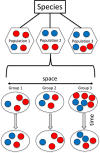Adult sex ratios: causes of variation and implications for animal and human societies
- PMID: 36402823
- PMCID: PMC9675760
- DOI: 10.1038/s42003-022-04223-w
Adult sex ratios: causes of variation and implications for animal and human societies
Erratum in
-
Author Correction: Adult sex ratios: causes of variation and implications for animal and human societies.Commun Biol. 2022 Dec 7;5(1):1341. doi: 10.1038/s42003-022-04296-7. Commun Biol. 2022. PMID: 36477424 Free PMC article. No abstract available.
Abstract
Converging lines of inquiry from across the social and biological sciences target the adult sex ratio (ASR; the proportion of males in the adult population) as a fundamental population-level determinant of behavior. The ASR, which indicates the relative number of potential mates to competitors in a population, frames the selective arena for competition, mate choice, and social interactions. Here we review a growing literature, focusing on methodological developments that sharpen knowledge of the demographic variables underlying ASR variation, experiments that enhance understanding of the consequences of ASR imbalance across societies, and phylogenetic analyses that provide novel insights into social evolution. We additionally highlight areas where research advances are expected to make accelerating contributions across the social sciences, evolutionary biology, and biodiversity conservation.
© 2022. The Author(s).
Conflict of interest statement
The authors declare no competing interests.
Figures





References
-
- Wedekind C, Küng C. Shift of spawning season and effects of climate warming on developmental stages of a grayling (Salmonidae) Conserv. Biol. 2010;24:1418–1423. - PubMed
-
- Capdevila P, Stott I, Beger M, Salguero-Gómez R. Towards a comparative framework of demographic resilience. Trends Ecol. Evol. 2020;35:776–786. - PubMed
-
- Katzner TE, et al. Assessing population-level consequences of anthropogenic stressors for terrestrial wildlife. Ecosphere. 2020;11:e03046.
-
- Schacht R, Rauch KL, Borgerhoff Mulder M. Too many men: the violence problem? Trends Ecol. Evol. 2014;29:214–222. - PubMed

